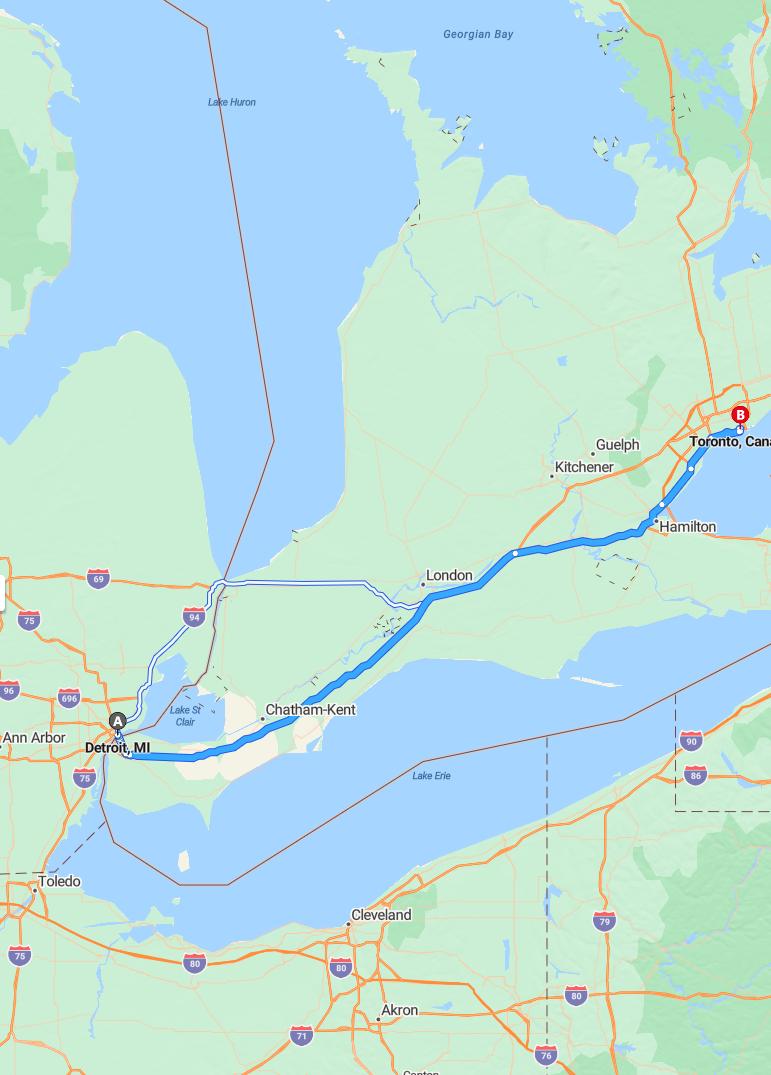Distance and estimated driving time
The drive from Detroit to Toronto covers approximately 231 miles and takes an estimated 3 hours and 39 minutes. Travelers typically take the ON-401 E and ON-403 E highways for this route, offering a straightforward and efficient journey. It is advisable to plan for potential border crossing delays and check traffic conditions beforehand. Ensuring your travel documents are up to date will help facilitate a smooth crossing into Canada and enjoy a seamless trip to Toronto.
Driving route
Embarking on a road trip from Detroit, Michigan, to Toronto, Canada, offers a scenic journey through several vibrant cities. Starting in Detroit, travelers can enjoy its rich automotive history before heading north to Chatham-Kent, known for its picturesque landscapes and cultural attractions. Continuing westward, London provides a perfect spot for a rest or meal, featuring diverse dining options and parks. As the route progresses, Hamilton stands out with its thriving arts scene and beautiful waterfalls, making it a worthwhile stop. Finally, the journey concludes in Toronto, Canada's bustling metropolis renowned for its iconic skyline, diverse neighborhoods, and cultural experiences.

Border crossing requirements and procedures
When traveling from Detroit to Toronto, travelers must pass through border crossing procedures at the U.S.-Canada border. Valid travel documents such as a passport or Nexus card are typically required for identification and entry purposes. Customs officials may ask about the purpose of your visit, the duration of your stay, and any goods you are bringing into Canada. Ensuring compliance with these requirements helps facilitate a smooth border crossing for travelers heading from Detroit through Chatham-Kent, London, Hamilton, and finally reaching Toronto.
Best time to travel for avoiding traffic
The best time to travel from Detroit to Toronto to avoid traffic congestion is early in the morning, ideally between 5:00 a.m. and 7:00 a.m., when most commuters are still at home. Traveling during mid-morning to early afternoon, around 10:00 a.m. to 2:00 p.m., can also help avoid peak travel times, especially near major cities like London and Hamilton. Avoiding late afternoon and early evening hours, approximately 3:00 p.m. to 7:00 p.m., is advisable, as this period experiences heavy commuter traffic heading into Toronto. Planning your trip during weekdays outside of rush hours and checking real-time traffic updates can further ensure a smoother journey along this route.
Vehicle documentation and insurance needs
When driving from Detroit to Toronto, travelers must carry valid vehicle documentation, including proof of registration and proof of insurance, to comply with cross-border requirements. Canadian authorities require drivers to present proof of insurance that meets Canadian standards, which may differ from those in the United States. It is essential to verify that your insurance policy extends coverage to Canada or to obtain a temporary international insurance card if necessary. Additionally, a valid driver's license, vehicle registration, and potential travel visas or permits should be accessible to facilitate smooth transit across all listed en route cities, from Detroit through Chatham-Kent, London, Hamilton, and finally Toronto.
Road conditions and traffic updates
Drive from Detroit to Toronto typically offers smooth highway conditions, though motorists should remain cautious of potential traffic congestion near major cities like London and Hamilton. Recent reports indicate occasional delays due to construction zones and peak-hour traffic, especially during rush hours. Weather conditions are generally favorable, but travelers should stay updated on any winter storms or precipitation that could impact road safety. It is advisable to check real-time traffic updates before departure to ensure a smooth journey across the border and through the Canadian provinces.
Parking options in Toronto
Toronto offers a variety of parking options to accommodate visitors and residents alike. Downtown, numerous surface lots and multi-level parking garages are available, often located near popular attractions, shopping districts, and landmarks. Street parking is also available through metered spots and designated zones, though it can be limited and more expensive in busy areas. For longer stays, many parking facilities provide daily or hourly rates, and some offer online reservation options to ensure convenient access to parking in this bustling city.
Fuel stations along the route
Traveling from Detroit to Toronto, drivers will find several fuel stations conveniently located along the route to ensure a smooth journey. In Detroit, numerous gas stations like Shell and Exxon are readily available before crossing the border. As you pass through Chatham-Kent and London, amenities such as Petro-Canada and Shell are accessible for refueling and quick stops. Approaching Hamilton and finally Toronto, travelers can easily locate fuel stations to replenish their tanks, making the trip seamless and well-prepared.
Customs and immigration processes at the border
When traveling from Detroit to Toronto, travelers must go through customs and immigration procedures at the border crossing. Upon arrival, passengers are typically required to present valid identification, such as a passport or enhanced driver's license, and may need to declare any goods or merchandise they are bringing into Canada. Customs officers may ask questions about the purpose of the trip, residence, and items being carried to ensure compliance with Canadian regulations. The process generally involves a brief inspection, after which travelers can proceed into Canada if all requirements are satisfied, making the transition between the United States and Canada smooth and secure.
Local driving laws and regulations in Ontario
When driving in Ontario, it's essential to adhere to local laws and regulations designed to promote safety and efficiency on the roads. Orders such as maintaining a maximum speed of 100 km/h on highways and obeying designated traffic signals are strictly enforced. Additionally, all drivers must carry valid insurance, registration, and a valid driver's license, whether from Ontario or another jurisdiction. It is also mandatory to wear a seatbelt at all times and refrain from using handheld devices while driving to prevent distractions and reduce accidents.
